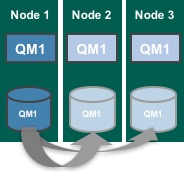
Compromise is everywhere. We are told to take the rough with the smooth. The easy with the hard. The quick win and the hard slog. And with software we often have to accept compromises. Especially so these days with the drive for new function forcing some compromises with stable deployments.
Not so with the latest update to the MQ family of products. For the last 15 months IBM has been delivering updates to MQ using a Continuous Delivery stream. There have been many useful additions, but they have always required adoption of the latest version to take advantage of the new features. With the latest update moving to MQ V9.0.4, there are even more substantial updates of useful features for both base MQ and MQ Advanced. However in recognition of the need for customers to keep some systems back-level while also wanting to take advantage of new features, some of these updates are designed to allow existing deployed systems to take advantage of the new capabilities, both without being updated and without breaking the Continuous Delivery and Long Term Support principles.
In addition to this extremely useful update, which I will get to in a minute, which can be used across the entire MQ estate, there are some groundbreaking updates that will allow huge changes in the way MQ is used, deployed and managed in this update. It is more leaps forward rather than steps forward.
For MQ Advanced we have 3 key new capabilities:
- A new ‘easy HA’ feature – Replicated Data Queue Managers
- More flexible Managed File Transfer deployments
- Availability of an enhanced Blockchain bridge
For MQ Base (which is part of MQ Advanced) there are a number of other enhancements
- Additional commands supported as part of the REST API for admin
- Availability of a ‘catch-all’ for MQSC commands as part of the REST API for admin
- Ability to use a single MQ V9.0.4 Queue Manager as a single point gateway for REST API based admin of other MQ environments including older MQ versions such as MQ V9 LTS and MQ V8.
- Ability to use MQ V9.0.4 as a proxy for IBM Cloud Product Insights reporting across older deployed versions of MQ
- Availability of an enhanced MQ bridge for Salesforce
- Initial availability of a new programmatic REST API for messaging applications
All of these features are called out in the new announcement letter for MQ V9.0.4 here. And there are further updates available for the MQ Appliance listed in the specific announcement letter for it here and in another blog entry here. There are also announcement letters for IBM MQ z/OS V9.0.4 and IBM MQ Advanced for z/OS VUE V9.0.4
However, let’s try and call out some details of the key points of the MQ V9.0.4 update below:

The new High Availability feature (officially described as Replicated Data Queue Managers or RDQM) provides a significant new way to configure High Availability. It is only available for MQ Advanced users on x86 Red Hat Linux. It is designed as a 3 node system which uses replication of messages and logs between the local disks available to each Queue Manager. This style of replication of local disks was previously only available with the MQ Appliance. As moving to this new style of HA will allow customers to stop using network storage for MQ, we anticipate it will be very popular. As well as the disk level replication, Floating IP will be used to help applications move seamlessly to a failover QM. And 3 nodes help to prevent ‘split-brain’ situations where 2 nodes are simultaneously active.
The licensing of the above deployment requires MQ Advanced as already stated. However as long as all Queue Managers on all 3 nodes are Replicated Data Queue Managers, and all 3 systems are the same capacity, then only one node needs to have a MQ Advanced license entitlement. The other 2 nodes can be licensed with MQ Advanced High Availability Replica parts (these parts used to be called Idle Standby parts).

The changes to the REST API for admin are also significant. Over the last few releases more and more ‘verbs’ have been added to allow REST API calls to configure and manage MQ. This was designed to allow more modern tools to be built as an alternative to MQSC and PCF based tooling. The latest V9.0.4 release adds more verbs and also a way to call the remaining equivalent MQSC functions within a REST API structure. However what is perhaps more interesting is that a single V9.0.4 Queue Manager can now act as a ‘gateway’ Queue Manager to allow these new REST API driven tools to configure and manage Queue Managers that are older and don’t include this new Continuous Delivery function. This is hopefully a very good way of providing the best of both worlds. Allowing the older production Queue Managers to remain deployed but still take advantage of new features.
Similar to this ‘bridge’ feature is one for IBM Cloud Product Insights, where the ability to publish deployed Queue Manager data to Cloud Product Insights was limited to releases on the Continuous Delivery stream, but now a single V9.0.4 Queue Manager enables older installs to publish data to this useful dashboard tool.
The MQ bridge for Salesforce has been enhanced to allow MQ to publish data into Salesforce, instead of simply receiving push notifications from Salesforce.
Customers with MQ Advanced who want to explore the possibilities offered by Blockchains now can deploy a bridge which enables MQ applications to query the Blockchain, and also provide data input into it. An earlier version of this was available only to customers with MQ Advanced for z/OS VUE, but this version is available to customers using MQ Advanced on distributed platforms.
MQ Advanced customers also get more flexibility in how they can deploy the file logger in MQ Managed File Transfer scenarios, as this logger can now be deployed on a different machine to the MQ Queue Manager.
And finally, feedback from customers told us that developers were looking to make sure of MQ, but with fewer dependencies, to free them up from client and language bindings. As such we have also added the first layer of support for a new set of programmatic REST APIs for messaging applications. This will replace the previous HTTPBridge function which has already been deprecated. Over the next few releases it is hoped that more functions will be supported in this REST API for messaging to allow additional messaging calls to be supported.
Counting up the advances it does look like it is more than 2 steps forward, and certainly no steps back. And with the ability to use some of these features alongside your older MQ releases, what are you waiting for? Download it from here today. Or try it on Amazon AWS Quick Start.
Want to know more. Check out the webcast. Register or replay at this link.
Tags: Amazon AWS, AWS, AWS Quick Start, Blockchain, Floating IP, High Availability, IBM MQ, IBM MQ Advanced, MFT File Logger, MQ Advanced, MQ High Availability Replica, MQ Idle Standby, MQ MFT, MQ V9.0.4, MQSC, RDQM, Replicated Data Queue Managers, REST API, REST API for Messaging, Salesforce, Security
October 24, 2017 at 10:18 am
[…] Blogging about Messaging, Connectivity and more « Two steps forward, no steps back with IBM MQ V9.0.4 […]
October 31, 2017 at 11:49 am
[…] Two steps forward, no steps back with IBM MQ V9.0.4 […]
October 31, 2017 at 12:12 pm
[…] Two steps forward, no steps back with IBM MQ V9.0.4 […]
July 3, 2018 at 8:57 am
[…] can read some of my past blog entries covering the prior V9.0.x releases (V9.0.1, V9.0.2, V9.0.3, V9.0.4, and […]